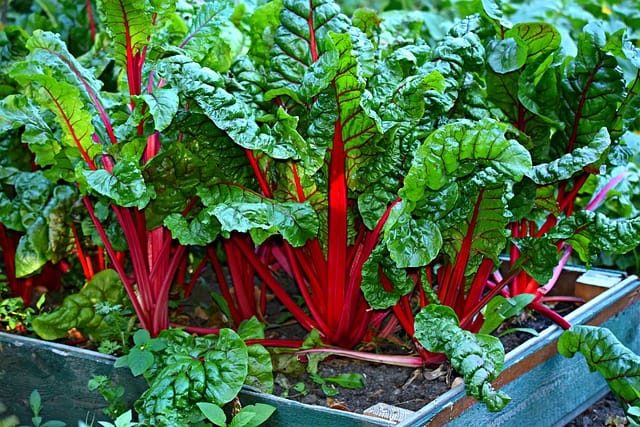Swiss chard, with its vibrant, colorful stems and large, slightly crinkled leaves, is a feast for the eyes and a treat for the taste buds. It’s a close relative of beets and spinach, sharing their earthy sweetness and nutritional benefits. And the best part? It’s incredibly easy to grow, even if you’re a beginner gardener.
Imagine strolling through your garden, the sun dappling the colorful chard leaves, and harvesting a bunch for your dinner. That satisfying snap as you cut the stems, the fresh, earthy scent – it’s a taste of homegrown goodness you won’t soon forget. Whether you’re a seasoned or beginner gardener, Swiss chard is a fantastic addition to your garden.

Why Grow Swiss Chard?
- Nutrient Powerhouse: Swiss chard is packed with vitamins, minerals, and antioxidants, making it a super healthy addition to any diet.
- Easy to Grow: Swiss chard is relatively easy to grow, even for beginner gardeners. In fact, it is one of the 13 best easy-to-grow garden vegetables!
- Colorful and Beautiful: The vibrant stems and leaves of Swiss chard add a touch of beauty to your garden.
- Versatile Veggie: From salads to stir-fries to soups, Swiss chard can be used in a wide variety of culinary creations.
- Continuous Harvest: You can harvest Swiss chard leaves continuously throughout the growing season, ensuring a steady supply of fresh greens.
- Cold-Hardy: Swiss chard can tolerate cooler temperatures, making it a great choice for early spring and fall plantings.
How to Eat Swiss Chard:
- Sautéed Sensations: Sautéed Swiss chard with garlic and olive oil is a quick, easy, and delicious side dish.
- Stir-Fried Delights: Swiss chard adds a vibrant color and earthy flavor to stir-fries.
- Soups and Stews: Swiss chard can be added to soups and stews for extra nutrition and flavor.
- Salad Star: Young, tender Swiss chard leaves can be used in salads.
- Frittatas and Quiches: Swiss chard adds a pop of color and nutrients to frittatas and quiches.
- Wraps and Rolls: Large Swiss chard leaves can be used as wraps or rolls for various fillings.
Growing Swiss Chard:
Swiss chard is a biennial, but it is usually grown as an annual. It is a cool-season crop and can be planted in early spring or late summer.
- Planting Power: You can start Swiss chard seeds indoors a few weeks before the last frost or sow them directly into the ground once the soil has warmed up.
- Watering Wisdom: Swiss chard needs consistent moisture, especially during germination and growth.
- Fertilizing Fundamentals: Swiss chard benefits from regular feeding with a balanced fertilizer.
- Sunshine State of Mind: Swiss chard prefers full sun to partial shade.
- Soil Savvy: It grows best in well-drained soil that is rich in organic matter.
- Harvesting Happiness: Swiss chard leaves can be harvested when they are large enough to use. Cut the outer leaves, allowing the inner leaves to continue growing.
Tips and Tricks:
- Pest Patrol: Keep an eye out for common pests like slugs and aphids.
- Succession Planting: Plant a new batch of seeds every few weeks for a continuous harvest throughout the season.
- Mulching Magic: Mulching around Swiss chard plants helps retain moisture and suppress weeds.
- Don’t Overwater: Overwatering can lead to root rot.
- Blanching: Blanching the stems by mounding soil around them can make them more tender and milder in flavor.
Swiss Chard Cuisine:
Swiss chard is incredibly versatile in the kitchen. Let’s try a recipe that’s a little more creative than just sautéing it:
Swiss Chard and Ricotta Stuffed Shells:
This is a hearty and flavorful vegetarian dish.
- 1 pound jumbo pasta shells
- 1 bunch Swiss chard, chopped
- 15 ounces ricotta cheese
- ½ cup grated Parmesan cheese
- 1 egg
- 1 clove garlic, minced
- Salt and pepper to taste
- Your favorite tomato sauce
- Cook pasta shells according to package directions.
- Sauté chopped Swiss chard with garlic until wilted.
- In a bowl, combine ricotta cheese, Parmesan cheese, egg, salt, and pepper.
- Add the sautéed Swiss chard to the ricotta mixture.
- Stuff cooked pasta shells with the ricotta and Swiss chard mixture.
- Pour some tomato sauce in a baking dish.
- Arrange the stuffed shells in the baking dish.
- Top with more tomato sauce and Parmesan cheese.
- Bake at 375°F (190°C) for 20-25 minutes, or until bubbly and heated through.
Nutritional Value:
According to the USDA FoodData Central, Swiss chard is an excellent source of vitamins A and K, as well as a good source of vitamin C, magnesium, and iron. It is also low in calories and fat.
| Nutrient | Amount per 100g |
|---|---|
| Calories | 19 kcal |
| Vitamin K | 830 mcg |
| Vitamin A | 12173 IU |
| Vitamin C | 30 mg |
| Magnesium, Mg | 51 mg |
| Iron, Fe | 3.4 mg |
Summary and Conclusion:
Swiss chard is a fantastic addition to any garden, especially for beginner gardeners. It’s easy to grow, packed with nutrients, and oh-so-delicious. So grab some seeds or seedlings, get your hands a little dirty, and experience the joy of growing your own Swiss chard!
Disclaimer: This post is for informational purposes only and should not be construed as health, wellness or nutrition advice. Please see our full disclaimers here.
« Back to Glossary Index
